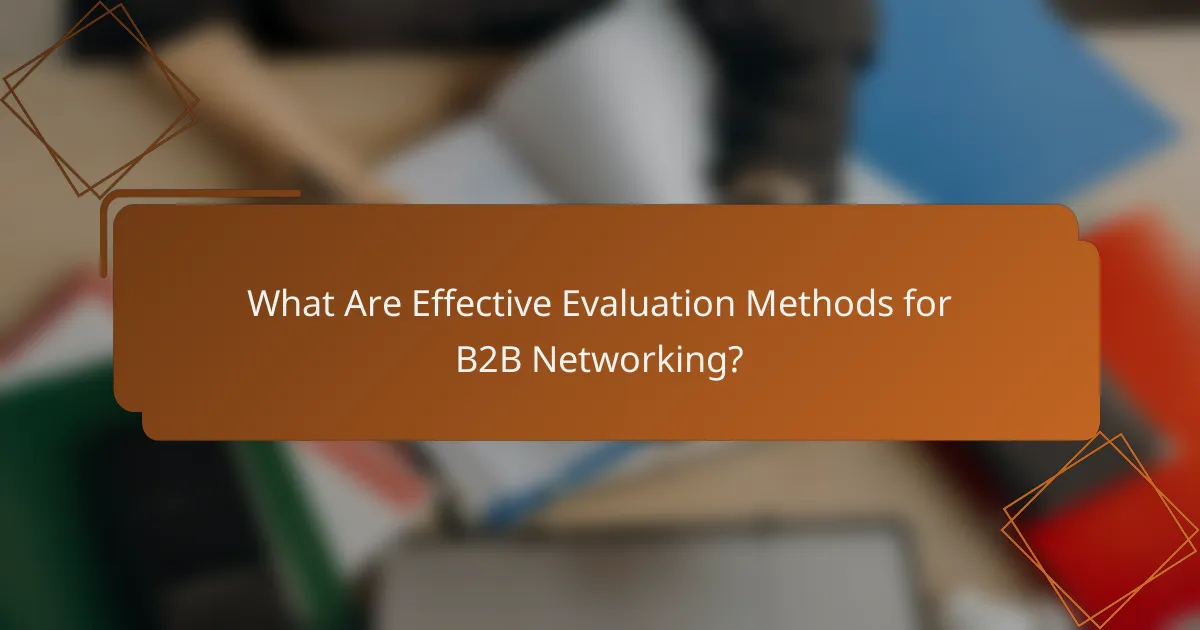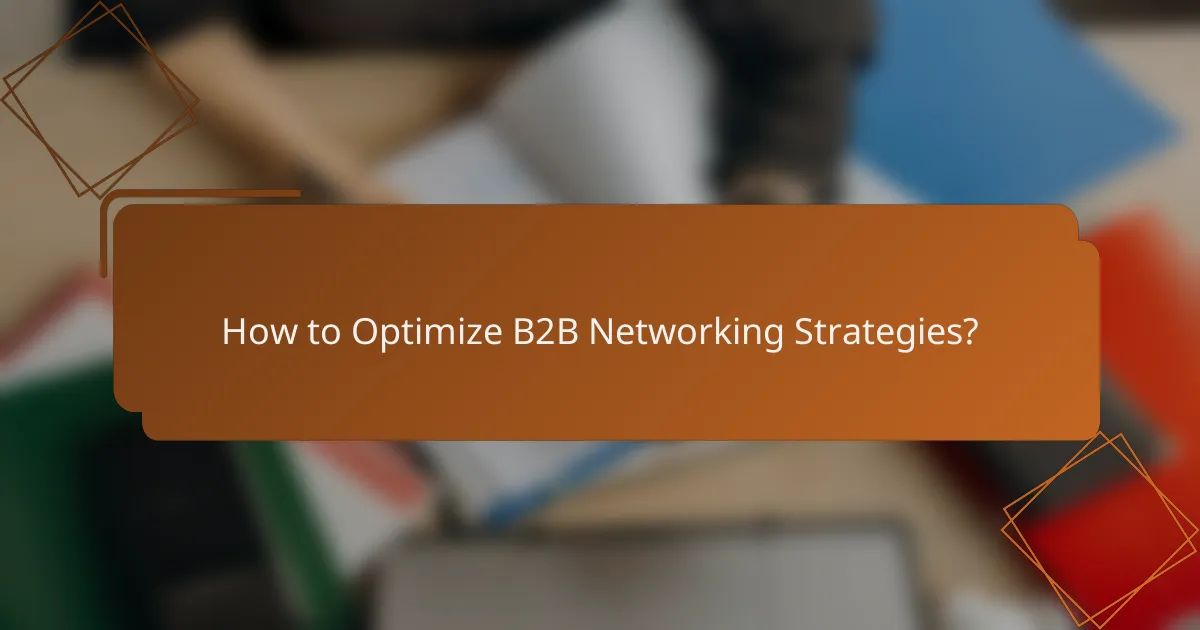Measuring the return on investment (ROI) of B2B networking is essential for businesses aiming to assess the value of their networking activities. By evaluating both tangible and intangible benefits, companies can gain insights into the financial and strategic impact of their networking efforts. Effective evaluation methods enable businesses to quantify these benefits against costs, guiding future investment decisions and maximizing the effectiveness of their connections.

How to Measure B2B Networking ROI?
Measuring B2B networking ROI involves evaluating both tangible and intangible benefits gained from networking activities. This assessment helps businesses understand the financial and strategic value of their networking efforts.
Quantitative metrics
Quantitative metrics provide measurable data that can directly link networking activities to financial outcomes. Common metrics include increased sales revenue, cost savings, and the number of new leads generated. For example, tracking the percentage increase in sales after a networking event can help quantify its effectiveness.
Other useful quantitative measures might include the average deal size or the conversion rate of leads to customers. Establishing clear numerical goals before networking can facilitate more accurate ROI calculations.
Qualitative assessments
Qualitative assessments focus on the subjective benefits of networking, such as relationship-building and brand reputation. Gathering insights from team members about their experiences can reveal how networking has enhanced partnerships or opened new opportunities. These insights can be just as valuable as numerical data.
Consider conducting surveys or interviews to capture qualitative feedback. This can help identify strengths and weaknesses in your networking strategy, providing a more comprehensive view of its impact.
Benchmarking against industry standards
Benchmarking against industry standards allows businesses to compare their networking ROI with peers. This can highlight areas for improvement and set realistic expectations. For instance, if similar companies report a 20% increase in leads from networking, this can serve as a target for your organization.
Utilizing industry reports or networking associations can provide relevant benchmarks. Regularly reviewing these standards ensures that your networking efforts remain competitive and effective.
Customer feedback analysis
Analyzing customer feedback is crucial for understanding the impact of networking on client relationships. Feedback can reveal how networking has influenced customer satisfaction and loyalty. For instance, if clients mention improved communication or service following networking events, this indicates positive ROI.
Implementing regular feedback mechanisms, such as post-event surveys or follow-up interviews, can help gather this information. This data can guide future networking strategies and enhance overall effectiveness.
Long-term relationship value
Evaluating the long-term relationship value involves assessing how networking contributes to sustained business relationships. This includes measuring repeat business, referrals, and partnerships that develop over time. The value of a strong relationship often extends beyond immediate financial returns.
To gauge this, track metrics like customer retention rates and the lifetime value of clients acquired through networking. Understanding these long-term benefits can justify the investment in networking activities, even if immediate returns are not apparent.

What Are Effective Evaluation Methods for B2B Networking?
Effective evaluation methods for B2B networking focus on quantifying the benefits gained from networking activities against their costs. These methods help businesses understand the impact of networking on their overall performance and guide future investment decisions.
Cost-benefit analysis
A cost-benefit analysis (CBA) compares the total expected costs of networking initiatives against the anticipated benefits. This method requires identifying all relevant costs, such as event participation fees, travel expenses, and time invested, alongside the potential gains like new leads, partnerships, or sales increases.
To conduct a CBA, list all costs and benefits, assign monetary values where possible, and calculate the net benefit. A positive net benefit indicates that the networking initiative is worthwhile, while a negative result suggests reconsideration or adjustment of strategies.
Return on investment (ROI) calculations
ROI calculations measure the efficiency of networking investments by comparing the net profit generated from networking activities to the total costs incurred. The formula for ROI is: (Net Profit / Total Costs) x 100. A higher percentage indicates a more effective networking strategy.
When calculating ROI, consider both direct financial returns and indirect benefits, such as brand awareness or market positioning. Regularly assessing ROI can help refine networking strategies and prioritize high-performing activities.
Net promoter score (NPS)
The Net Promoter Score (NPS) gauges customer loyalty and satisfaction by asking clients how likely they are to recommend your business to others. This score can provide insights into the effectiveness of networking efforts in building strong relationships.
To calculate NPS, survey clients and categorize their responses into promoters, passives, and detractors. Subtract the percentage of detractors from the percentage of promoters. A high NPS indicates successful networking and positive client relationships, while a low score may highlight areas for improvement.
Customer lifetime value (CLV)
Customer lifetime value (CLV) estimates the total revenue a business can expect from a customer throughout their relationship. Understanding CLV helps businesses evaluate the long-term impact of networking on customer acquisition and retention.
To calculate CLV, consider average purchase value, purchase frequency, and customer lifespan. By comparing CLV against the costs of networking initiatives, businesses can determine whether their networking efforts are generating sustainable value.

What Factors Influence B2B Networking Success?
B2B networking success is influenced by several key factors that determine the effectiveness of connections made during networking events. Understanding these elements can help businesses maximize their return on investment from networking efforts.
Industry relevance
Industry relevance plays a crucial role in B2B networking success. Engaging with contacts who operate within the same sector or related fields increases the likelihood of meaningful exchanges and opportunities. For instance, a technology firm networking with other tech companies can lead to collaborations or partnerships that are more impactful than those with businesses in unrelated industries.
When selecting networking events or platforms, prioritize those that cater specifically to your industry. This focus ensures that discussions are relevant and that the potential for valuable connections is maximized.
Networking platform choice
The choice of networking platform significantly affects the quality of connections made. Whether attending in-person events, utilizing online platforms, or participating in industry forums, each option has its strengths and weaknesses. In-person events often foster deeper relationships, while online platforms can offer broader reach and convenience.
Evaluate the platforms based on your target audience and goals. For example, LinkedIn is effective for professional connections, while industry-specific conferences may provide more targeted networking opportunities. Choose platforms that align with your networking objectives.
Participant engagement levels
High participant engagement levels are essential for successful networking. Engaged participants are more likely to share insights, ask questions, and foster connections. Look for events that encourage interaction, such as workshops or roundtable discussions, rather than passive presentations.
To boost engagement, consider strategies like icebreaker activities or structured networking sessions. These approaches can help participants feel more comfortable and willing to connect, enhancing the overall networking experience.
Follow-up strategies
Effective follow-up strategies are critical for converting initial networking interactions into lasting relationships. After meeting potential contacts, promptly reach out with a personalized message to reinforce the connection. This could be as simple as a thank-you email or sharing relevant resources discussed during the event.
Establish a system for tracking your connections and scheduling follow-ups. Regular check-ins, such as quarterly updates or invitations to future events, can help maintain relationships and open doors for future collaborations. Avoid letting connections fade by being proactive in your outreach efforts.

How to Optimize B2B Networking Strategies?
To optimize B2B networking strategies, focus on building meaningful connections that align with your business goals. This involves identifying key stakeholders, employing effective outreach methods, and leveraging technology to enhance relationships.
Targeted outreach techniques
Targeted outreach techniques involve identifying specific individuals or companies that align with your business objectives and reaching out to them directly. This can include personalized emails, tailored invitations to events, or one-on-one meetings that address their unique needs.
Consider using tools like LinkedIn Sales Navigator to refine your search for potential contacts based on industry, role, and location. Prioritize quality over quantity; a few well-researched connections can yield better results than mass outreach.
Common pitfalls include generic messaging and lack of follow-up. Always personalize your communication and ensure you have a clear value proposition that resonates with the recipient.
Leveraging social media platforms
Leveraging social media platforms is essential for expanding your B2B networking reach. Platforms like LinkedIn, Twitter, and even Facebook can help you connect with industry professionals, share insights, and engage in discussions relevant to your field.
Utilize LinkedIn groups to participate in conversations and showcase your expertise. Regularly share valuable content that addresses common challenges in your industry, which can attract potential partners and clients.
Be mindful of your online presence; ensure your profiles are complete and professional. Avoid overly promotional posts, as they can deter engagement. Instead, focus on building relationships through genuine interactions and valuable contributions.
